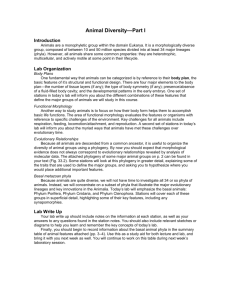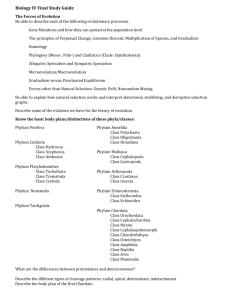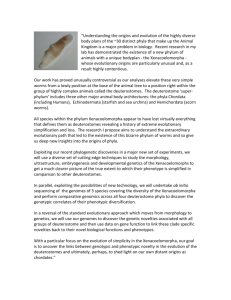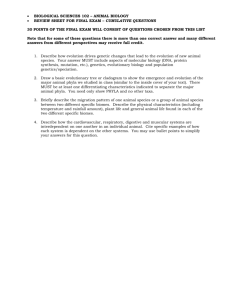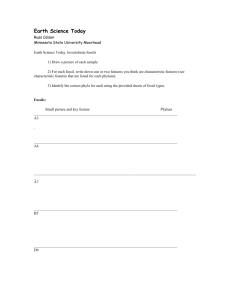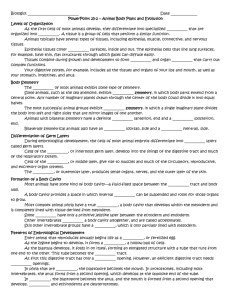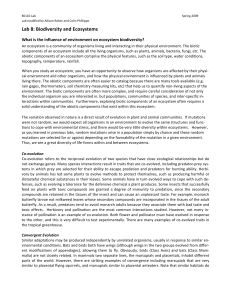Biology 10
advertisement
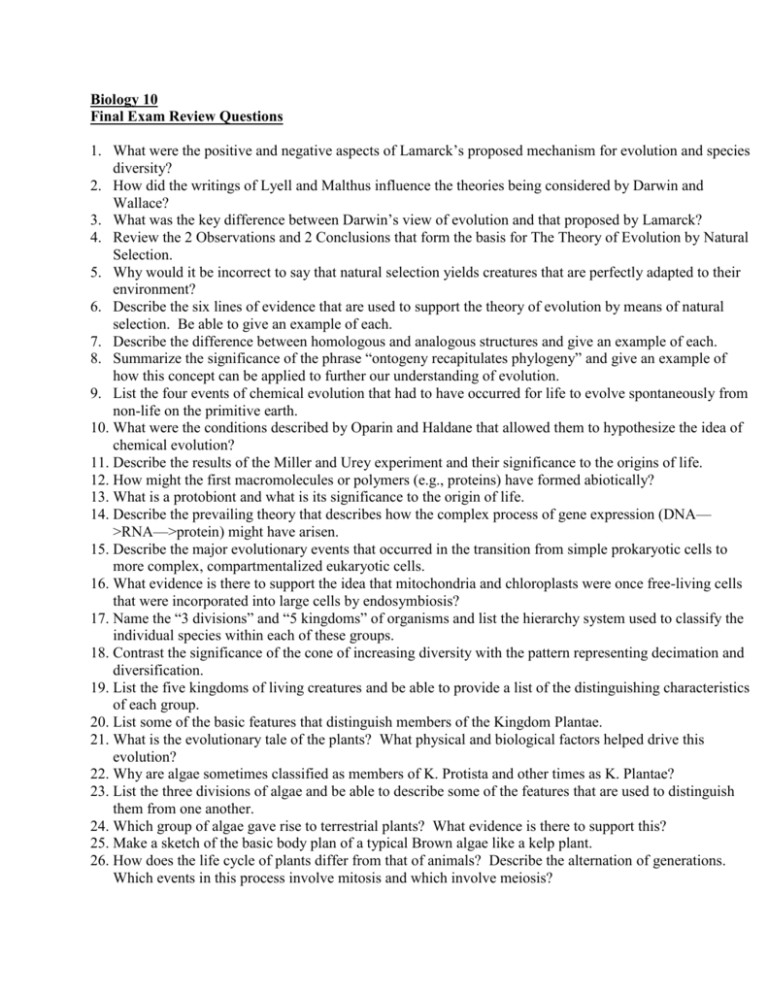
Biology 10 Final Exam Review Questions 1. What were the positive and negative aspects of Lamarck’s proposed mechanism for evolution and species diversity? 2. How did the writings of Lyell and Malthus influence the theories being considered by Darwin and Wallace? 3. What was the key difference between Darwin’s view of evolution and that proposed by Lamarck? 4. Review the 2 Observations and 2 Conclusions that form the basis for The Theory of Evolution by Natural Selection. 5. Why would it be incorrect to say that natural selection yields creatures that are perfectly adapted to their environment? 6. Describe the six lines of evidence that are used to support the theory of evolution by means of natural selection. Be able to give an example of each. 7. Describe the difference between homologous and analogous structures and give an example of each. 8. Summarize the significance of the phrase “ontogeny recapitulates phylogeny” and give an example of how this concept can be applied to further our understanding of evolution. 9. List the four events of chemical evolution that had to have occurred for life to evolve spontaneously from non-life on the primitive earth. 10. What were the conditions described by Oparin and Haldane that allowed them to hypothesize the idea of chemical evolution? 11. Describe the results of the Miller and Urey experiment and their significance to the origins of life. 12. How might the first macromolecules or polymers (e.g., proteins) have formed abiotically? 13. What is a protobiont and what is its significance to the origin of life. 14. Describe the prevailing theory that describes how the complex process of gene expression (DNA— >RNA—>protein) might have arisen. 15. Describe the major evolutionary events that occurred in the transition from simple prokaryotic cells to more complex, compartmentalized eukaryotic cells. 16. What evidence is there to support the idea that mitochondria and chloroplasts were once free-living cells that were incorporated into large cells by endosymbiosis? 17. Name the “3 divisions” and “5 kingdoms” of organisms and list the hierarchy system used to classify the individual species within each of these groups. 18. Contrast the significance of the cone of increasing diversity with the pattern representing decimation and diversification. 19. List the five kingdoms of living creatures and be able to provide a list of the distinguishing characteristics of each group. 20. List some of the basic features that distinguish members of the Kingdom Plantae. 21. What is the evolutionary tale of the plants? What physical and biological factors helped drive this evolution? 22. Why are algae sometimes classified as members of K. Protista and other times as K. Plantae? 23. List the three divisions of algae and be able to describe some of the features that are used to distinguish them from one another. 24. Which group of algae gave rise to terrestrial plants? What evidence is there to support this? 25. Make a sketch of the basic body plan of a typical Brown algae like a kelp plant. 26. How does the life cycle of plants differ from that of animals? Describe the alternation of generations. Which events in this process involve mitosis and which involve meiosis? 27. Contrast the differences between the aquatic and terrestrial habitats in terms of their suitability for colonization by plants. 28. Be able to compare the adaptations of each of the following groups of terrestrial plants in terms of size, dispersal and fertilization: bryophytes, ferns, gymnosperms and angiosperms. 29. For the plant phyla listed above, describe the changes in their life cycles that account for some of the success of the higher plant groups. 30. What was the adaptive basis for the shift from predominant gametophyte form observed among mosses and the predominant sporophyte that is found among all vascular plants? 31. What adaptations did gymnosperms have that allowed them to thrive at a time when the earth was experiencing a period of extensive drought and glaciation? How has their means of dispersal changed from that of ferns? Why does the embryo of conifers stand a better chance of survival than that of ferns? 32. Describe the components of a seed. Which groups of plants are capable of producing seeds? 33. Be able to draw a flower and label its parts. Do the tissues inside the flower represent the sporophyte or the gametophyte? 34. Distinguish between the functions of xylem and phloem tissues found in higher vascular plants. 35. What adaptations present in flowering plants (angiosperms) allowed them to out compete conifers and eventually cover most of the earth? 36. What is the meaning of the phrase “mutualistic coevolution”? How is it relevant to plant evolution? 37. What is the purpose of a fruit? 38. Be able to define the word adaptation, and distinguish how this word carries a different meaning as applied to evolution, systematics, and interpretive biology. 39. What theories have been proposed to account for why animals have evolved to display such a huge diversity of forms and body plans relative to the other multicellular kingdoms. 40. What are the challenges and advantages posed by the three basic environments in which animals are found: marine, freshwater, and terrestrial? 41. Describe the significance of each of the following requirements seen in animals as they involve the acquisition of new adaptations to solve these problems: Exchange of respiratory gases, Obtaining nutrients, Ability to circulate gases and nutrients, Disposal of cellular wastes, Ability to balance water and salt concentrations, Ability to reproduce and develop, Support and movement of tissues 42. How does the body plan of animals change as they evolve into more complex forms? 43. For each of the 8 invertebrate phyla presented in lab, indicate where they occur on the phylogenetic tree and be able to describe their body plan and how they have solved the animal requirements described above. 44. Be able to explain the various “sign posts” on the evolutionary tree which we use over and over in the lecture. What do the terms Parazoa, Eumetazoa, Radiata, Bilateria, Protostome, Deuterostome, Lophotrochozoa, and Ecdysozoa all mean? 45. What is the phylum name of sponges? Why are these considered to be simple creatures relative to all other animal phyla? 46. Describe the two body plans exhibited among cnidarians. What level of organization do they exhibit? How do they feed? What new innovations appear in these animals for the first time in K. Animalia? What type of symmetry do they exhibit? 47. What is the first group of organisms to exhibit bilateral symmetry and a hunting life style? What accounts for the fact that they have an organ level of organization? 48. How do flatworms exchange gases? Are they free-living or parasitic or both? 49. To which phylum do snails, clams, and octopus belong? What are the three main regions of their body? What is the special feeding structure found only in members of this group? 50. How do octopus and squid differ from all of the other members of this phylum in terms of their feeding strategy? How has their circulatory system evolved to support this more active life style? 51. What group evolved segmentation for burrowing? What advantages does a segmented body plan provide? What role does the coelom play in the body of these organisms? 52. What phylum includes roundworms? How does their digestive tract differ from that of their ancestors? Of what value is the presence of a body cavity (coelom) in these creatures? What is the shape and general size of the animals in this group? 53. Name 4 different types of arthropods. What trait is characteristic of this group? What type of skeletal structure do these animals have and how does it affect their pattern of growth? How is this skeletal system adaptive for land? 54. Which group exhibits 5 part radial symmetry? Why is this group considered to be closely related to the phylum to which we humans belong? Name 4 different animals in this group. What unique system is found among members of this group that is involved in feeding and locomotion? 55. What phylum are vertebrates found in? What are the characteristics that distinguish the phylum Chordata from all of the invertebrate phyla? 56. The earliest fishes are classified in the Class Agnatha. What two evolutionary adaptations appear in fishes that led to the extinction of this group and to the evolution of all other vertebrates? 57. What adaptation had to have occurred in the body plan of fishes that enabled their descendants to evolve onto the land? 58. How well adapted were the amphibians for terrestrial life? In what way is their life cycle analogous to that of ferns? 59. Why were reptiles more successful on the land than amphibians? 60. What reproductive adaptation did reptiles have that allowed them to reproduce independent of an aquatic environment? Describe the functions of each of the four extraembryonic membranes of the amniotic egg. Make a drawing of a cross-section of a reptile egg that show these structures. 61. What other vertebrate groups also have the amniotic egg? 62. Which classes of vertebrates are characterized as being endotherms? How is the behavior of an ectotherm likely to differ from that of an endotherm? 63. List some of the adaptations seen in birds that are related to flight? 64. What are the principal adaptations found in mammals? Contrast the adaptations seen in birds and mammals that allow these two groups to conserve heat? 65. Distinguish between three groups of mammals, the monotremes, marsupials, and placentals, in terms of how their young develop. 66. What two membranes found in the reptile egg evolved into the placenta and umbilical cord in placental mammals? 67. Try to assemble a timeline of evolutionary events that includes the four big waves of evolutionary innovation and what majors features distinguish each wave; namely, 1. when simple cells evolved, 2. when complex cells evolved, 3. when multicellular creatures first appeared, 4. when major animal groups appeared.
